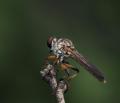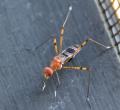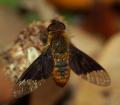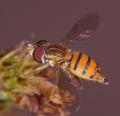Diptera.info :: Identification queries :: Diptera (adults)
Who is here? 1 guest(s)
|
Empid fly ?
|
|
| fleabag |
Posted on 25-04-2007 14:13
|
|
Member Location: Sussex UK Posts: 183 Joined: 13.07.06 |
Hi, Please could anyone help with this? found in rural sussex uk ...seemed quite small i thought ..maybe 8ish mm? thanks, Noel. fleabag attached the following image:  [81.15Kb] |
| igor |
Posted on 25-04-2007 15:14
|
|
Member Location: Posts: 297 Joined: 23.11.06 |
Hilara sp. |
|
|
|
| Adrian |
Posted on 25-04-2007 15:50
|
|
Member Location: Posts: 69 Joined: 05.01.07 |
I think it might be Hilara curtisi |
|
|
|
| Paul Beuk |
Posted on 25-04-2007 16:51
|
|
Super Administrator Location: Netherlands Posts: 19403 Joined: 11.05.04 |
Little chance that it is anything else, but even for this species the legs are very dark. In 'normal' specimens at least the knees should be yellowish.
Paul - - - - Paul Beuk on https://diptera.info |
| fleabag |
Posted on 25-04-2007 17:01
|
|
Member Location: Sussex UK Posts: 183 Joined: 13.07.06 |
im guessing the big hairy elbow pads are for display? thanks for the helpful replies  |
| Adrian |
Posted on 25-04-2007 18:56
|
|
Member Location: Posts: 69 Joined: 05.01.07 |
Sometime even the 'knees' are quite dark in H. curtisi in English populations. I've checked the male genitalia on many occasions but they are always curtisi. The males do use the elbow pads in display:- holding them in front as they try to attract females. In most Hilara, the swollen metatarsi are associated with production of silk which is used to wrap prey for presentation to the female. However, not all hilara with greatly swollen metatarsi actually use silk in their epigamic display. I can't remember exactly what curtisi does but if you are really interested I can look it up in my field notes |
|
|
|
| Paul Beuk |
Posted on 25-04-2007 19:14
|
|
Super Administrator Location: Netherlands Posts: 19403 Joined: 11.05.04 |
And for fleabag's information: The 'elbow pads' are actually part of the tarsus ('the hands' , as the elbow would be equivalent to the knee, the joint between femur and tibia. You might compare them with boxing gloves. , as the elbow would be equivalent to the knee, the joint between femur and tibia. You might compare them with boxing gloves. 
Paul - - - - Paul Beuk on https://diptera.info |
| igor |
Posted on 25-04-2007 20:48
|
|
Member Location: Posts: 297 Joined: 23.11.06 |
Adrian: check Chvala, 2005: 63  |
|
|
|
| Paul Beuk |
Posted on 25-04-2007 21:11
|
|
Super Administrator Location: Netherlands Posts: 19403 Joined: 11.05.04 |
Chv?la (2005: 63): Biology. - According to Plant (pers. comm.), a typical species of narrow ditches with slow flowing water in southern and eastern England; swarms have been observed several times in a ditch by a tall hedge in an otherwise open situation, in a pool behind a marine shingle bar in Dorset, or over stagnant pools on a track in the sunshine; many males were skimming the surface of the pool, scavenging insects trapped on the surface, and if injured insects were dropped on to the surface they were immediately pounced upon by males. However, males have never been observed by Plant flying with prey, even in compact nearby swarms of several hundred individuals that are only a few cm away from the skimming males; motion in the swarms was rather slow, and entire swarms retreated to nearby bushes when a slight wind occurred. Mating takes place in the swarm and copulating pairs remain in the swarm, definitely without any prey or any silk object transfer. On brackish coastal grazing marshes in Somerset, males commonly swarm in deep ditches according to Plant, for instance in the open over Lemna covered ditches and under the deep shade of bankside vegetation. (Any spelling errors hereby attributed to the OCR-program.  ) )
Paul - - - - Paul Beuk on https://diptera.info |
| Jump to Forum: |













